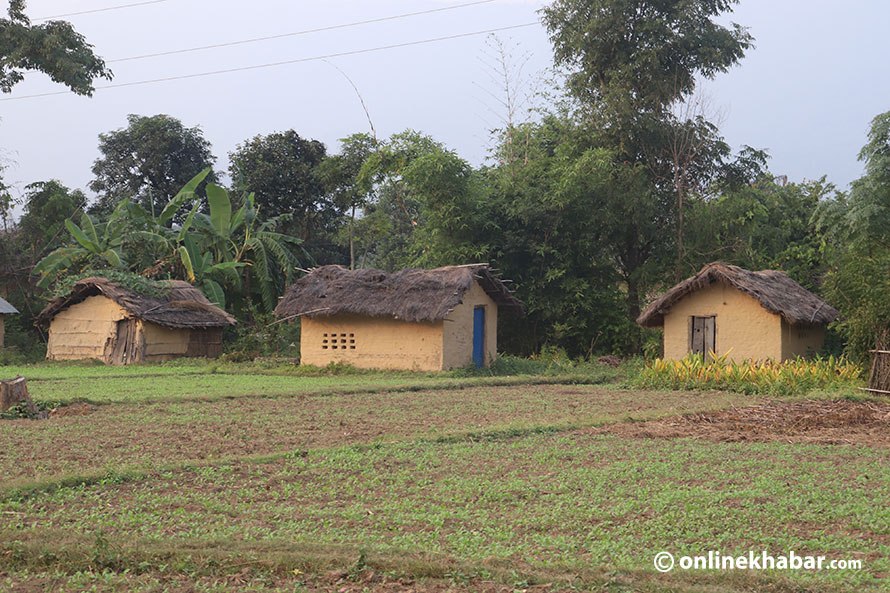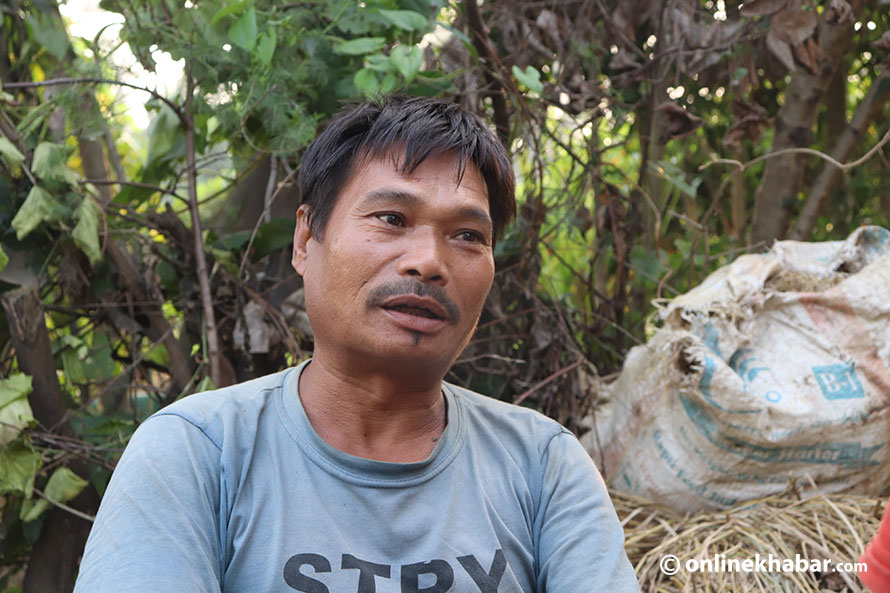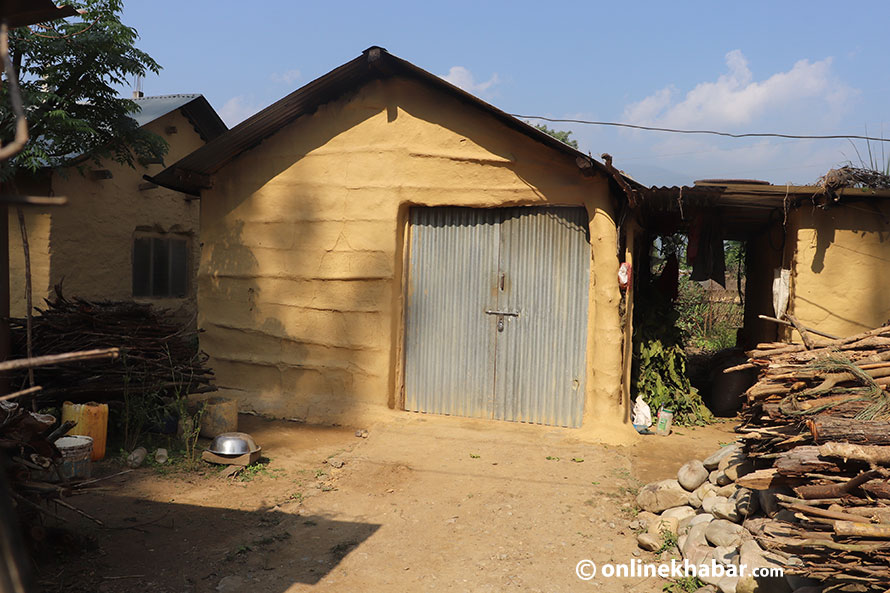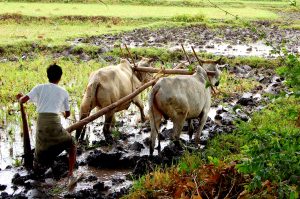
Most houses at Mukta Basti, in Dang’s Deukhuri valley, are padlocked. The settlement, near Rapti rural municipality, is home to the marginalised community, most of whom worked as kamaiyas (or bonded labourers).
Most of these houses are built with mud and locally available materials. Not many people live in this village as most have left for foreign employment in India while some have gone to the Gulf countries.
According to a resident of the village, Dhaniram Chaudhary, 50, most go away because there is no choice. No one in the village has their own land, which means they do not have the means to practise agriculture to sustain themselves.
“You will find it difficult to spot men in the village. As they want better lives for themselves and their families, most have gone to Bihar looking for work,” says Chaudhary.
When freedom meant nothing
After the government announced the end of the kamaiya system and the emancipation of bonded labourers in July 2000, Dhaniram’s family were free. But as they had worked more than half their lives for another person, they had no land or place to call home.
The announcement left many without land, a home and a means to make ends meet. Nothing has changed for them until now.
Dhaniram’s father Bhagiram Chaudhary also worked as a kamaiya at a rich person’s home. Without land or employment, he worked there for over 30 years. Like his father, his brothers Hulram and Maniram also worked in similar conditions for 25 and five years, respectively. Dhaniram also became one of the kamaiys, but he quit after nine months. Unlike his father and brothers, he left for India.

A kamaiya’s life was full of hardships yet simple. They had to look after the land owned by the rich, plough it and plant grains. For that, they got to keep around 500 kilograms of grains every harvest season. They received nothing extra and the 500 kg of grains they got was not enough to sustain themselves for a year.
“But, once we were free, we had no idea what to do. We didn’t know how to fill our stomachs,” says Dhaniram.
Looking for a place to live, his family ended up in Rapti rural municipality. During that time, various people like Bhagiram went to that place and established a settlement there.
Dreams deferred
Initially, Dhaniram’s family had come and settled here in the hope that the government would give them land after their “emancipation.” Many political leaders during their speeches also promised that they would give these people ownership of land, but two decades have passed by and these families are still landless.
“My brother hoped that after 25 years of being a kamaiya, he would have been offered land. My father had expected it too, but both have stopped hoping,” says Dhaniram.

Dhaniram feels he has inherited his father’s struggle and fears that his children will have to inherit his.
“I don’t want my children to be landless like my father and me,” he says.
Dhaniram understands that not having land ownership has major repercussions and he does not want his future generation to face the issues he had to face.
“I’m sure I would have done something if I had owned land. Maybe I would have leased it to start a business or I’d have just done farming,” he says.
But as he does not have one, he is frustrated and has resorted to becoming a daily wage labourer, which is not enough to sustain himself.
“I might go to India now like everyone,” he says.
The status quo
There are 92 families in the Mukta Kamaiya Basti, a settlement of freed labourers, who are all facing the same fate. All of them are waiting for the government to come up with policies to help them. But, in Dang, Banke and Bardiya, the lives of kamaiyas have worsened.
Sabitra Chaudhary’s father was a kamaiya for his entire life. Sabitra, herself served the role for 15 years. She did not even get to go to school.
Her father-in-law was also a kamaiya for life. Like everyone else, after emancipation, he too became landless and now Sabtira and her husband are also living life without their own land.

It has been more than a decade since she started living in this settlement with her husband. Her husband, like others in the village, has left Nepal for foreign employment.
“We no longer face difficulties from those landlords, to whom we used to work. Instead, we face difficulties because we don’t have any land,” says Sabtira, adding life has not been better.
After emancipation, she repeatedly protested demanding land for people like her but their demands have not been met. Hence, she wants to continue fighting for land not just for herself, but for the future generation.
Political inaction
A reason why nothing has changed is politics. The kamaiya emancipation becomes a political issue every time during the elections as leaders give these people fake promises in return for votes.
“Now we see how fake their promises are,” says Sabitra.
Hulram, who served as a kamaiya for 40 years is also landless. He has asked politicians and government officials to give him land, but his words have gone in vain.
“I’m old and tired and can’t fight for the cause anymore. I just hope these people understand our pain and not give us fake promises but do something about us,” says Hulram.
The people living in Mukta Kamaiya Basti now fear that they might have to move as the capital of Lumbini province has moved to Bhalubang in Dang.
Sumitra Chaudhary says that the rumours of the provincial government talking about displacing the settlement is giving them sleepless nights.
“Rather than telling leaders to give us the land ownership of the land where we’ve build houses, we have started asking them not to remove us from here,” says Sumitra.
According to the Mukta Kamaiya Samaj, an organisation of the freed labourers, there are 4,811 kamaiyas in Dang. Out of those, only 1,426 have received identification from the government.
The organisation’s district president Harish Chandra Chaudhary says that among those who have received identity cards, only 705 people have received land ownership certificates. Out of them, 17 people are yet to receive the land.
This story was translated from the original Nepali version and edited for clarity and length.






















